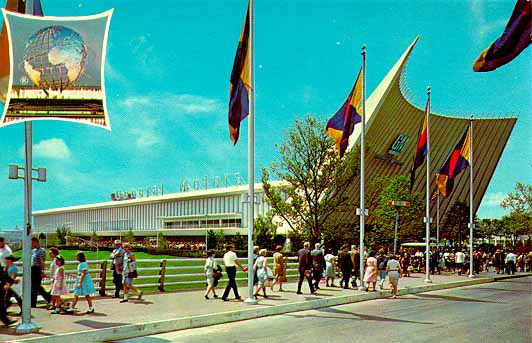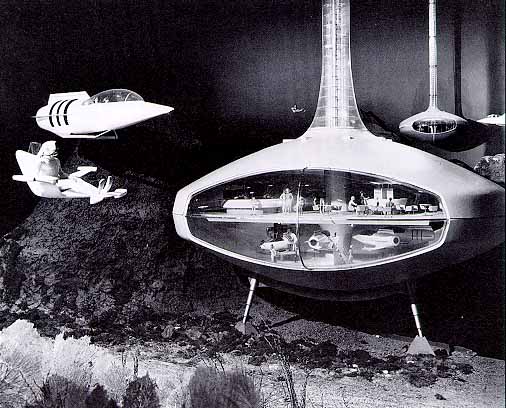General Motors Pavilion
The General Motors Pavilion, one of the larger pavilions at the Fair, had an enormous slanted canopy 110 feet high perched over its entrance. Its long rectangular building housed its "Futurma" exhibit, a detailed yet knowledgeable look at the technological developments awaiting mankind in the near future. In many ways it was similar to its 1939 exhibit at that World's Fair, but 25 years later, futurists and scientists hopefully could make a better educated prediction.
| The General Motors Pavilion. |
In their updated version of GM's classic ride into the future, visitors sat in individual contoured seats with speakers in the head rest, as their seats moved along a track that alternately dipped and climbed through the exhibition hall's two floors.
The ride began with a trip to the moon where visitor's cars passed a scale model of a cratered moon landscape. Manned "lunar-crawlers" and commuter space ships populates the desolate landscape.
Futurama predicted that man would settle and work the bottom of the seas. Models showed minerals being hauled to the surface by submarine train, and vacationers relaxing in a sub-oceanic resort equipped with oxygen, and riding about outside on "aqua-scooters."
 |
A sub-oceanic resort where visitors played outside on aqua-scooters. |
Spectators watched technology harvest a jungle. Machines felled towering trees with searing laser light and a road builder, five stories high and longer than three football fields, followed the timber cutter. Amazingly, it leveled and graded the devastated forest, and it left behind a divided, multi-lane super highway in its path. The road served a city that processed the timber and chemicals derived from the "tamed" jungle.
Deserts were tamed, too, Crops were shown thriving in soil irrigated with desalted sea water. Machines operated by remote control planted and harvested the crops.
The "City of the Future" was shown with midtown airports, high-speed trains, super skyscrapers, moving sidewalks and underground conveyor belts for freight.
 |
The city of the future where super skyscrapers were serviced by high speed trains and pedestrians traveled between buildings on moving sidewalks. |
When the ride was over visitors entered GM's "Avenue of Progress" which showcased the company's space age research and product engineering. On display was a cosmic space chamber, applications of solar energy and turbine engines. Scientists showed new uses of metals, plastics and fabrics. Finally there were examples of the latest techniques in automotive design.